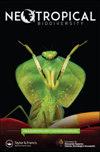Do arboreal termite nests increase mortality in Mauritia flexuosa L. f. (Arecaceae) during wildfires?
IF 0.8
Q4 ECOLOGY
引用次数: 0
Abstract
ABSTRACT Moriche palm (Mauritia flexuosa Linn f. [Arecaceae]) is a dominant species in the savanna margins of the Caribbean island of Trinidad. The savanna margins are frequently subjected to fires and the moriche palm, like many palm species, is adapted to cope with a degree of fire damage. These palms also frequently host large termite nests that tend to burn during fires, which causes further damage to the palm stems. This paper explores the possibility that the combination of termite nests and frequent fires can increase tree mortality. Two post-fire surveys were conducted to record, evidence of fire exposure, fire damage to termite nests and fire damage to palm stems. In both surveys, the majority of palms with termite nests suffered fire damage to their stems, while none of the termite-free palms showed damage. Furthermore, a comparison of nest size and damage to the bark showed stems with larger nests had significantly more damage than those with smaller or no nests. The results suggest that the presence of termite nests increases the extent of fire damage to palm trunks by providing a point of combustion that focuses flames on the already compromised stem tissue. Long-term studies are warranted to investigate the impact of repeated fires on wild arborescent palm populations.在野火期间,树栖白蚁巢穴是否会增加毛茛科植物的死亡率?
摘要:莫里切棕榈(Mauritia flexuosa Linn f.〔Arecaceae〕)是加勒比海特立尼达岛热带草原边缘的优势物种。稀树草原边缘经常受到火灾的影响,莫里奇棕榈和许多棕榈物种一样,能够适应一定程度的火灾破坏。这些棕榈树还经常有大型白蚁巢,在火灾中容易燃烧,这会对棕榈茎造成进一步的破坏。本文探讨了白蚁巢穴和频繁火灾相结合会增加树木死亡率的可能性。进行了两次火灾后调查,以记录火灾暴露、白蚁巢穴火灾损坏和棕榈茎火灾损坏的证据。在这两项调查中,大多数有白蚁巢穴的棕榈树的树干都受到了火灾的破坏,而没有白蚁的棕榈树受到了破坏。此外,对巢穴大小和树皮损伤的比较表明,巢穴较大的树干比巢穴较小或没有巢穴的树干损伤更大。研究结果表明,白蚁巢穴的存在通过提供一个燃烧点来将火焰集中在已经受损的树干组织上,从而增加了对棕榈树干的火灾破坏程度。有必要进行长期研究,以调查反复火灾对野生树栖棕榈种群的影响。
本文章由计算机程序翻译,如有差异,请以英文原文为准。
求助全文
约1分钟内获得全文
求助全文
来源期刊

Neotropical Biodiversity
Environmental Science-Ecology
CiteScore
1.80
自引率
0.00%
发文量
39
审稿时长
24 weeks
 求助内容:
求助内容: 应助结果提醒方式:
应助结果提醒方式:


